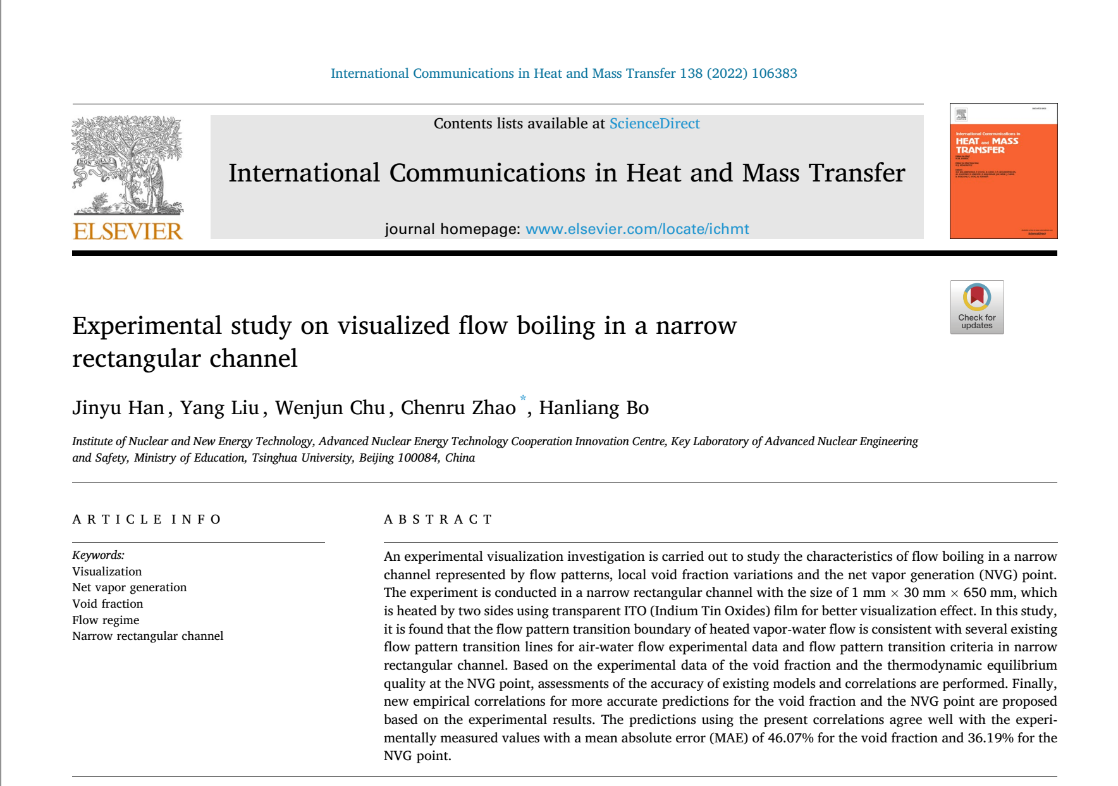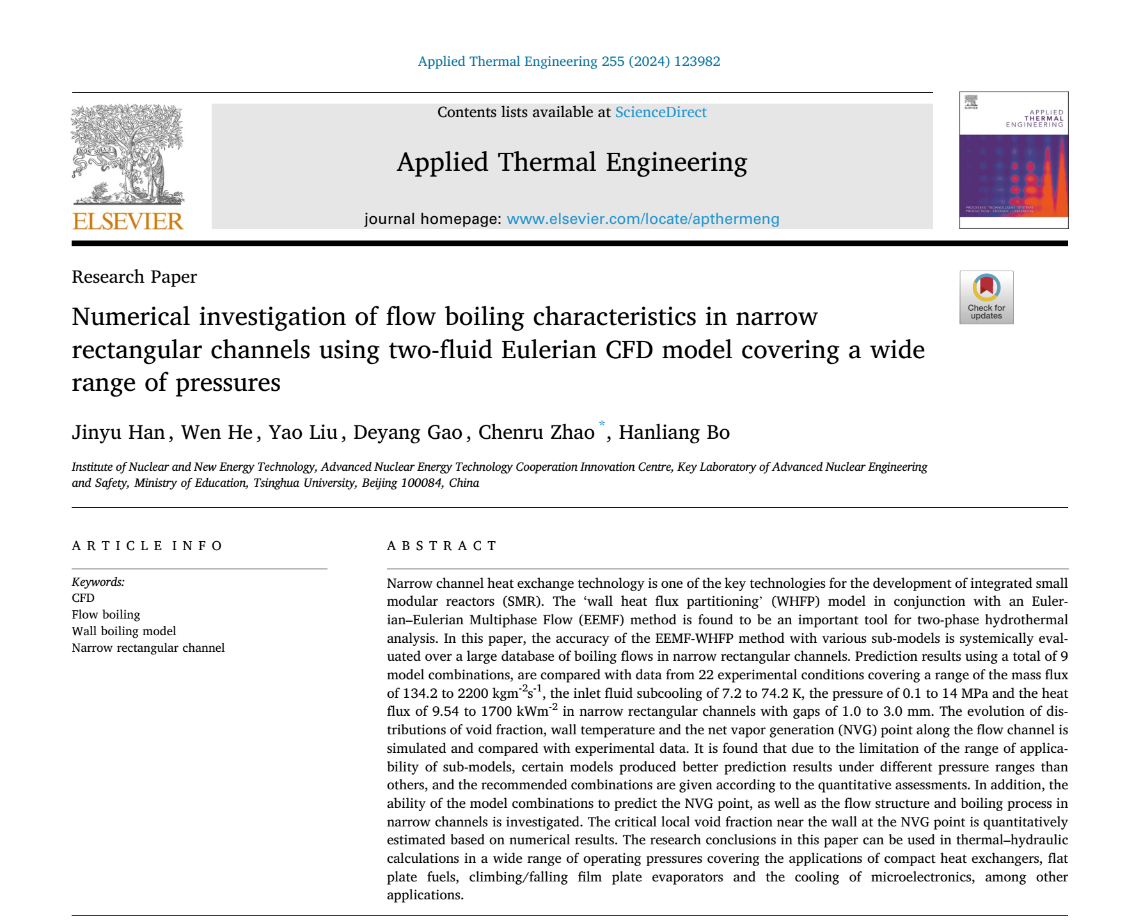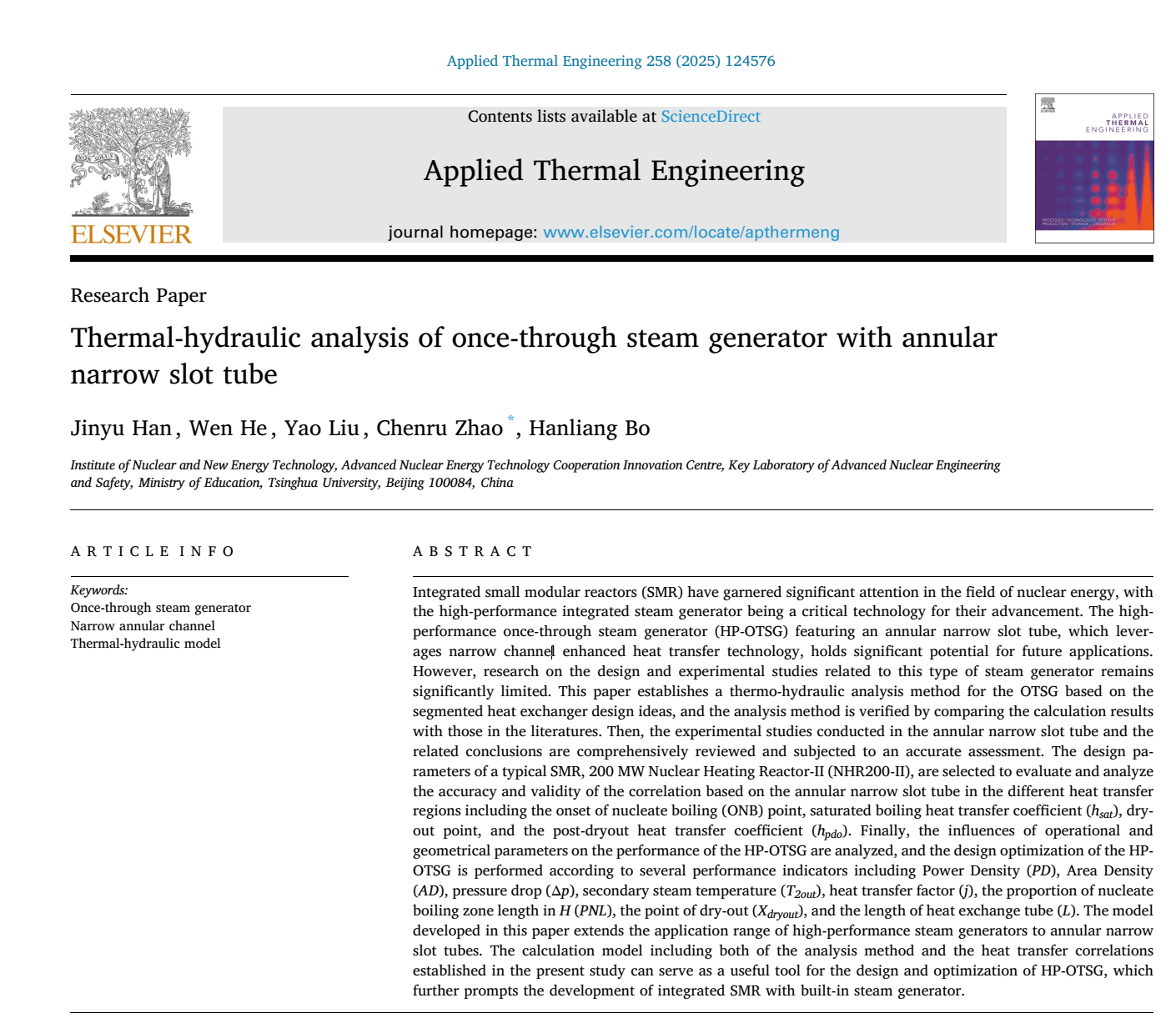Narrow channels with the hydraulic diameter ranging from 0.2 mm to 3 mm featured with high heat transfer efficiency are ideal to apply in the industrial heat exchangers such as the steam generator in the nuclear power device to achieve high compactness as well as high thermal-hydraulic performance. INET researchers have studied the flow boiling heat transfer characteristics in narrow channels and thermal hydraulic design in the high-performance steam generator with narrow channels by combining experimental research, theoretical analysis and numerical simulation against the application background of high-performance steam generator with narrow channels in the Small Modular Reactors (SMRs).
Zhao Chenru | INET news
January 14, 2025
One of the key technical hurdles in the advancement of SMRs is the design of steam generator with high efficiency and compactness that can meet the rigorous operational demands.
A research team led by Research Associate Professor Zhao Chenru and Professor Bo Hanliang of INET, Tsinghua University has proposed a novel design of a high-performance once-through steam generator (HP-OTSG) as shown in figures below. It employed annular narrow slot tubes as the core heat exchange component, focusing on optimizing the heat transfer efficiency and compactness of the steam generators for SMRs.

(a) NHR200-II type SMR (b) Core Heat Exchange Component (c) Schematic diagram heat exchange unit
A series of research results were published reporting the experimental investigations, theoretical analysis, and numerical simulations on the flow boiling characteristics within narrow channels, as well as the impact of different design parameters on various OTSG performance, focusing on heat transfer coefficients, tube-side pressure drops, and the compactness of the system structure to meet different design objectives.
1. Experimental study on visualized flow boiling in a narrow rectangular channel
The research team conducted visualization experiments on flow boiling in a narrow channel using "indium tin oxide (ITO) transparent heating film" and "high-speed camera combined with image processing technology" to provide basic data for the flow boiling heat transfer in narrow slot. The distribution of vapor-liquid flow patterns was plotted in the boiling flow pattern map. An experimental database was established for parameters such as boiling heat transfer flow patterns, void fraction, and net vapor generation (NVG) points in narrow channels. The effects of inlet subcooling, flow rate, and heat flux density on the development of flow patterns and void fraction were revealed. The predictive accuracy of existing correlations for the void fraction and NVG point was evaluated, and new empirical correlations with higher accuracy were proposed based on the experimental results.

2. Numerical investigation of flow boiling characteristics in narrow rectangular channels using two-fluid Eulerian CFD model covering a wide range of pressures
The research team systemically evaluated the accuracy of the EEMF-WHFP method with various sub-models based on a large database of boiling flows in narrow rectangular channels, avoiding the rather popular case-by-case tuning of descriptive models to a limited number of experiments. Prediction results using three bubble departure diameter models and three nucleation site density models, a total of 9 model combinations, were compared with data from 22 experimental conditions covering a range of the mass flux of 134.2 to 2200 kg/(m2s), the inlet fluid subcooling of 7.2 to 74.2 K, the pressure of 0.1 to 14 MPa and the heat flux of 9.54 to 1700 kW/m2 in narrow rectangular channels with gaps of 1.0 to 3.0 mm. The variations of void fraction, wall temperature and the net vapor generation (NVG) point along the flow channel was simulated and compared with experimental data.

3. Thermal-hydraulic analysis of once-through steam generator with annular
narrow slot tube
The research team established a thermo-hydraulic analysis method for the once-through steam generator (OTSG) based on the segmented heat exchanger design ideas. The analysis method was verified by comparing the calculation results with those in previous literatures. The design parameters of a typical SMR, 200MW Nuclear Heating Reactor-II (NHR200-II), were selected to evaluate and analyze the accuracy and validity of the correlations based on the annular narrow slot tube in different heat transfer regions including the onset of nucleate boiling (ONB) point, saturated boiling heat transfer coefficient (hsat), dry-out point, and the post-dryout heat transfer coefficient (hpdo). Finally, the influences of operational and geometrical parameters on the performance of the HP-OTSG were analyzed, and the design optimization of the HP-OTSG was performed according to several performance indicators, including Power Density (PD), Area Density (AD), pressure drop (∆p), secondary steam temperature (T2out), heat transfer factor (j), and the length of heat exchange tube (L).

Link to articles and more information:
https://www.sciencedirect.com/science/article/pii/S073519332200505X
https://www.sciencedirect.com/science/article/abs/pii/S1359431124016508
https://www.sciencedirect.com/science/article/abs/pii/S1359431124022440
https://mp.weixin.qq.com/s/iFJ7BBCQbiBiIBe0uJ_dcA
For consultation, please send an email to: zhaochenru@tsinghua.edu.cn